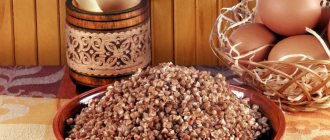Advantages of the diet
Although Bernstein's diet goes against scientific medicine in some ways, following it helps bring sugar levels equal to those of healthy people.
In addition to glucose, blood pressure and cholesterol are stabilized. Low-carbohydrate products, insulin, test strips require considerable expenses, but there is an opportunity to save on expensive medications.
The advantages of treating diabetes according to Bernstein include:
- the need to use medications is reduced,
- glucose levels return to normal levels,
- body weight reaches normal, the development of obesity is prevented,
- the condition of the retinal vessels is stabilized,
- blood pressure readings are normal,
- the feeling of hunger does not appear,
- memory improves,
- Fatigue and depression go away.
In addition, the Bernstein diet for diabetes is easily tolerated and has a beneficial effect on the entire body.
How can nutrition help prevent type 2 diabetes?
Key risk factors for prediabetes
People at increased risk of developing prediabetes and type 2 diabetes:
- overweight or obese;
- with a large waist circumference (the so-called “abdominal type” of obesity);
- having close relatives with diabetes (two or more relatives on the same line);
- over 40 years old.
The initial stage of type 2 diabetes, prediabetes, is characterized by an initial impairment of glucose absorption (glucose tolerance) and most often occurs without any noticeable symptoms. Therefore, it is important, especially in the presence of risk factors, to regularly monitor fasting blood glucose levels (in some cases and 2 hours after meals) at least once a year.
If you belong to a risk group for type 2 diabetes, this is not a “sentence” and, often, the development of type 2 diabetes can be prevented. To understand what exactly needs to be changed for this, let’s first of all understand what happens in this condition in the body.
Glucose is necessary for our energy supply, and insulin, which is produced in the pancreas, helps the body's tissues absorb this glucose. When there is not enough insulin produced, we talk about type 1 diabetes. Basically, this is a hereditary problem. If the body's tissues become less sensitive to the action of insulin, then this is the so-called insulin resistance or insulin resistance, which is observed in type 2 diabetes. At the same time, sugar (glucose) remains in the blood and its level rises. Type 2 diabetes usually occurs due to a combination of insulin resistance and lack of insulin.
What is prediabetes?
A person with prediabetes will, at times, have blood sugar levels higher than normal, which indicates that the body is beginning to have problems managing glucose, but (and this is important!) has not yet passed the “point of no return.” By changing your habits and, above all, your diet, you can help your body heal.
What to do if you are diagnosed with prediabetes?
Timely prescribed treatment, correction of diet and lifestyle at the stage of prediabetes will prevent the development of type 2 diabetes.
The main modifiable risk factor for type 2 diabetes is being overweight or obese. An active lifestyle and the following tips for changing your diet will help you lose weight and at the same time support your body from the inside:
1. Eat more fiber-rich foods
Fiber is beneficial to the body in many ways:
- it slows down the release of sugar from food into the blood. This means that the body will need less insulin for the tissues to absorb it.
- It is harder to digest and thus prolongs the feeling of fullness, which can reduce the desire to snack or eat something sweet, which will cause an increase in blood sugar.
There are two types of plant fiber that we can get from food: soluble and insoluble. The best option to help slow the release of sugar into the blood is soluble fiber. It can be found in foods such as legumes, nuts, seeds, fruits and vegetables. The recommended daily fiber intake is 18 grams per day, with high-fiber foods containing 6 grams or more per 100 grams of food.
2. Control your portion sizes
As mentioned above, it is very important to maintain a normal weight. Often the cause of obesity is not what people eat, but how much they eat.
It is not always easy to judge by eye what the correct serving size should be. An interesting technique is to use your own hands for this:
- a portion of protein food should be the size of your palm - your goal is three servings of protein food per day;
- serving of fruit or vegetable should be about the size of a handful—aim for at least five servings of fruit or vegetable per day;
- A serving of carbohydrates is about the size of your clenched fist - your goal is one serving at every meal
3. Make your body work
The body doesn't have to work as hard to digest refined and processed foods because some of the work is done before they even hit the store shelf. As a result, this can lead to a faster and larger release of sugar into the blood.
Therefore, it is better to choose products that are “closer” to their natural state:
- Give preference to whole grain bread, rice and durum wheat pasta.
- Leave the skins on fruits, vegetables and nuts.
- Eat high-fiber foods at the same time as foods that are naturally high in sugar, such as a few almonds at the same time as an apple.
- Use whole foods—fruit juice is absorbed by the body much faster than whole fruit, so it has a much greater impact on blood sugar levels.
4. Reduce the amount of carbohydrates in your diet
Carbohydrate-rich foods require the most insulin. Therefore, replacing some of the carbohydrates in your food with low-carb vegetables (such as leafy greens), “healthy” (plant-based) fats or proteins reduces your need for insulin.
One international study highlighting the benefits of dietary changes compared the effectiveness of a known blood sugar-lowering drug with intensive diet and lifestyle changes, including increasing the amount of fiber in the diet and weight loss efforts. After three years, the progression of prediabetes decreased by almost two-thirds in the group of patients who made lifestyle changes, and by only one-third in the group receiving medication, compared with the third group, which continued to live as before.
Here are the words of one of the patients who changed his fate: “Although I was shocked by the diagnosis, I realized the reason for what happened - I fell into the trap of constant haste. I realized I had to make a change, and that meant eating wisely and regularly. Diet changes combined with exercise are now part of my life. Eating healthy takes just a little planning and thinking (and that doesn't mean you can't eat something that's forbidden once in a while!), but it's all part of feeling good about yourself."
Blood sugar measurement frequency
Regardless of the form of the disease, each patient should measure their sugar readings themselves. The procedure is carried out at least 4 times a day for a week. The obtained data is entered onto the sheets of Glucograph III.
Monitoring allows you to evaluate the impact of medications and nutrition on sugar fluctuations. Only with the help of weekly indicators can you develop your own monosaccharide stabilization plan.
Before measuring, you must wash your hands thoroughly. It should be borne in mind that if the fingers come into contact with glucose preparations, alcohol and other substances, the indicators may become distorted to a greater extent. Keep the meter and hands warm. You can warm your hands with warm water.
In the table, each day is divided into columns and blocks. Life events that can affect glycemia are recorded in separate cells.
This may include:
- taking medications,
- physical activity,
- various infectious diseases,
- hypothermia,
- poor nutrition.
This table allows you to evaluate how various factors affect sugar and create an individual recovery program.
Methods
The researchers used the CENTRAL, Medline, Embase, CINAHL, CAB databases (until August 2021).
Randomized clinical trials that included a low-carbohydrate diet (<130 g/day or <26% of 2000 kcal/day) or a very low-carbohydrate diet (<10% of total calories) for at least 12 weeks were included in the analysis. in adult patients with diabetes.
As a primary endpoint
looked at diabetes remission (HbA1c <6.5% or fasting glucose <7.0 mmol/L, without or with antidiabetic medications), weight loss, HbA1c, fasting glucose, and incidence of adverse events.
As secondary endpoints
We looked at quality of life and biochemical blood test parameters.
Menu for the week
A menu compiled for the week allows you not only to plan your diet in advance, but also to control the glycemic index and financial costs of food.
Scales will help you keep track of the portions you eat. It is recommended to prepare food yourself, since it is impossible to trace what it was prepared from by someone else. In addition, it is recommended to keep a food diary, which will indicate the amount of food consumed, glucometer readings after eating it, and the body’s reaction to the introduction of new foods.
Dr. Bernstein's sample low-carb diet menu for diabetics for a week, based on the Bernstein diet.
| Day of the week | Breakfast | Dinner | Dinner |
| Monday | Omelet with steamed vegetables, green tea | Vegetarian borscht, boiled meat, fresh vegetable salad, compote | Cucumber and tomato salad, boiled fish, rosehip tea |
| Tuesday | Boiled vegetables, boiled egg, chicory drink | Buckwheat soup, boiled turkey meat, cabbage and carrot salad, green tea | Chicken fillet baked with vegetables and mushrooms, fruit tea |
| Wednesday | Omelet with tomatoes, green tea | Cabbage soup, steamed fish with vegetables, tea | Buckwheat porridge, cabbage and carrot salad, rosehip drink |
| Thursday | Vegetables with cheese, tea | Okroshka, lean pork, baked with vegetables, tea | Vegetable soup, kefir |
| Friday | Curd casserole, yogurt | Puree vegetable soup, boiled turkey, cabbage side dish, tea | Chicken baked with cheese, fruit tea |
| Saturday | Soft-boiled egg, green coffee | Vegetarian borscht, baked fish, tomato and cucumber salad, tea | Curd casserole, yogurt |
| Sunday | Cheese omelette, green tea | Mushroom puree soup, boiled beef, side dish of brown rice, compote | Baked fish, tea |
During a low-carbohydrate diet for type 2 diabetes, it is recommended to include a second breakfast, an afternoon snack and a second dinner. During these snacks you can eat fruits, vegetables, fermented milk drinks, and cottage cheese.
Thus, Dr. Bernstein's diet at first glance seems unusual and quite complex for diabetes. Most people find it difficult to give up or minimize their carbohydrate intake. In this case, experts recommend reducing the amount of carbohydrates gradually by about 20 g.
According to Bernstein, this approach also contributes to a significant improvement in well-being if the insulin regimen is properly organized.
Low-carbohydrate diet for diabetes by Dr. Bernstein
Recommended diet - Table No. 9 - is not the only panacea in organizing nutrition for diabetes. A real revolution in this was made by the American doctor Richard K. Bernstein, who himself became ill with insulin-dependent diabetes mellitus at the age of 12 in 1946. For the first 20 years, he ate according to the usual recommendations of doctors accepted in official medicine. When he turned 30, he already had many diabetic complications, in particular, kidney problems - nephropathy in the stage of proteinuria. This was in 1964.
Richard K. Bernstein - a doctor who defeated the complications of diabetes with a low-carbohydrate diet After this, Bernstein found a glucometer that was rare at that time and began measuring his blood sugar 5 times a day. Based on this, he developed his own diet, the feature of which was a significant restriction of carbohydrates in food.
His diet allowed him to recover his kidneys, and his proteinuria disappeared after he regained control of his sugars with a low-carb diet.
To convey his ideas to the masses, at the age of 45 he entered medical college, and in 1983 he began his own medical practice.
By 2008, at age 74, Bernstein had surpassed the average life expectancy of type 1 diabetics. He attributed his longevity to his commitment to a low-carbohydrate diet and the lifestyle he developed for diabetics.
In 2006, Bernstein's high-density lipoprotein (HDL) or "good" cholesterol levels were 118 mg/dL, his "bad" cholesterol was 53 mg/dL, his triglycerides were 45 mg/dL, and his average blood sugar level (glycosylated test) hemoglobin) was 83 mg/dL (or 4.6 mmol/L).
Dr. Bernstein strongly rejects the dietary guidelines for type 1 and type 2 diabetes recommended by the American Diabetes Association (ADA). By the way, the same recommendations have been adopted in Russian diabetology.
Basic principles of Dr. Bernstein's low-carb diet:
- Frequent blood sugar measurements throughout the day;
- an extremely low-carbohydrate diet to significantly improve blood sugar control. Bernstein believes that if you eat few carbohydrates, there will be no sudden spikes in sugar, which occur precisely because of carbohydrates. Thus, blood sugar becomes predictable;
- Carbohydrate Allowance: Maximum of 6 grams for breakfast, 12 grams for lunch, and 12 grams for dinner for a 140-pound adult;
- exclusion from the diet of the following products: with added sugar or honey, such as desserts, sweets, pastries; all products made from grains and flour, such as bread, cereals, pasta and rice; all starchy vegetables such as potatoes, corn, carrots, peas, beans; all fresh or canned fruits and fruit juices; all dairy products, except butter, cream and fermented cheeses;
- the patient takes responsibility for monitoring blood sugar levels, including daily blood glucose measurements up to 8 times a day, and sometimes at night;
- maintaining target blood glucose levels at a constant level throughout the day;
- weight loss for obese people with type 2 diabetes;
- mandatory physical activity for all patients with type 2 diabetes;
- basal and bolus dosed insulin therapy for diabetic patients receiving insulin.
Source:











